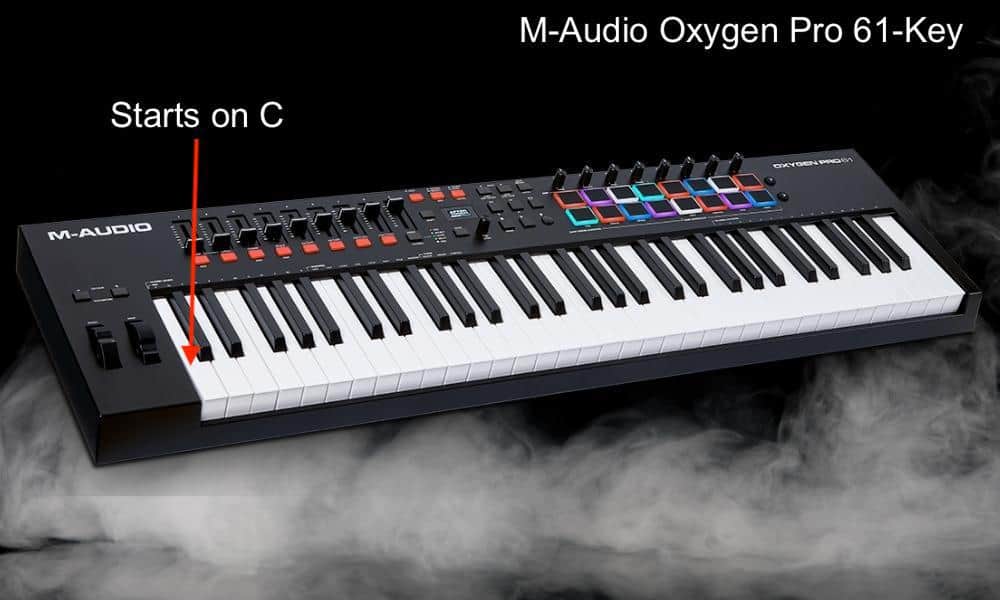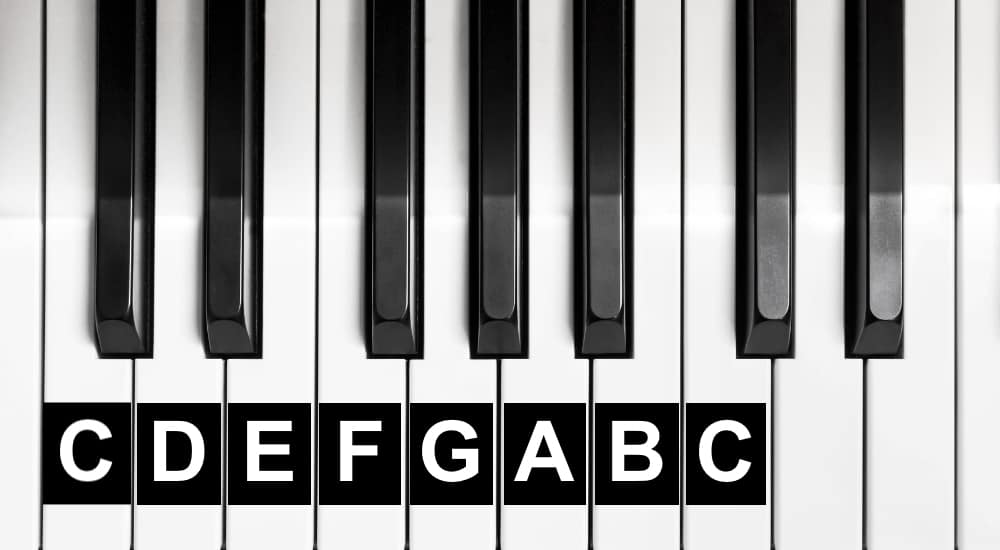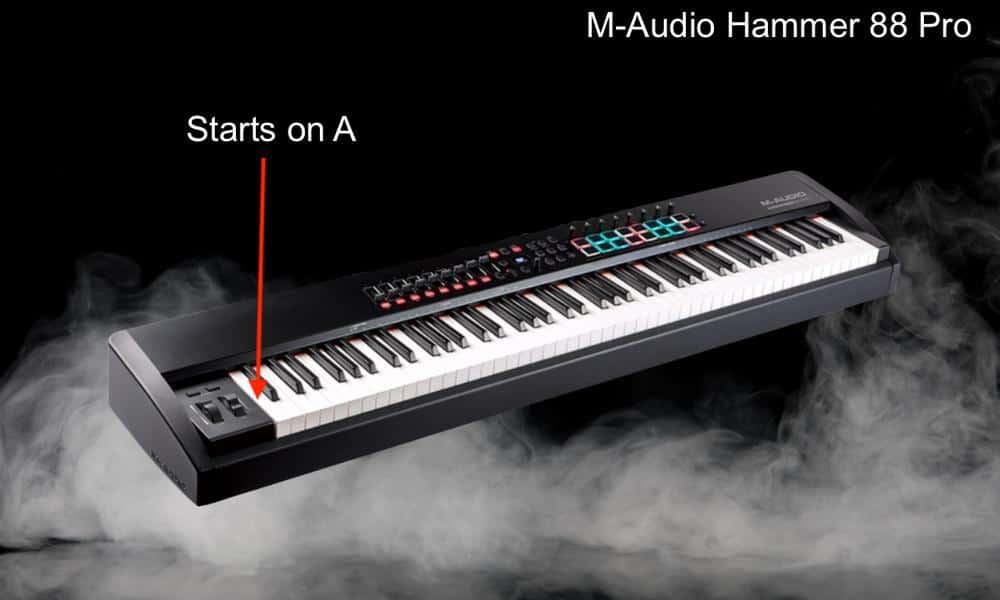Over the years, the piano has evolved into different variations which are meant for other purposes. Some are 25 keys, some are 49 keys, and some are 61 or 88 keys. They come in all shapes and sizes, but only the biggest ones start with “A0” while smaller ones do not. There’s a reason for this.
The main reason some pianos and keyboards start on C and not A is the number of keys. For instance, it’s not uncommon for a 49-key or 61-key model to start on C, whereas nearly all 88-key models – which is a full piano – will start on A.
Why Do Some Pianos Start on C and Not A?
Not all keyboards start on C and neither do they always start on A (although most of them do). It really depends on the model and the number of keys that you have.
For instance, a 49-key model like the Acorn Masterkey will often start on a C and the same thing goes for a 61-key model like the M-Audio Oxygen Pro 61.
1) It Depends On How Many Keys The Piano Has

Your piano will start on either A or C depending on the number of keys. Like I said in my article on why you need an 88-key piano to play “Fur Elise,” A 49-key model or a 61 key piano will start with C.
However, once you get to full, 88-key, grand pianos, digital pianos, and MIDI keyboards, you’ll notice how they always start on A and end on C. We’ll talk about a few reasons why this is the case in a moment.
2) C is a Great Option to Start on Because of the C Major Scale
The C Major scale is the easiest scale to start with primarily due to the lack of accidentals. There are no sharps or flats. And the nice thing about the piano is you can pick out all the notes of C Major because they’re all the white keys like what’s shown down here (more on the importance of C Major in my other article).

Many piano teachers will start their students off with learning middle C and learning the rest of the notes from there. Most familiar melodies use the major scale, which is the pattern outlined by the white keys of the piano if you’re in the key of C Major.
Like I said in my guide on how to learn music theory, the C Major scale is a great scale to start with when learning music theory because of the piano’s design. It’s like learning on easy mode, compared to the guitar which is more like a labyrinth due to the strings (more on this in “Why the Piano Isn’t Hard to Learn On Your Own).
Get Mark Sarnecki’s Complete Elementary Rudiments as well as the Answer Book (on Amazon) if you want to learn more about what terms like relative minor and C major mean.
![Mark Sarnecki's Complete Elementary Rudiments - Why Do Some Pianos Start With A C and Not an A [ANSWERED]](https://producersociety.com/wp-content/uploads/2022/03/Mark-Sarneckis-Complete-Elementary-Rudiments-Why-Do-Some-Pianos-Start-With-A-C-and-Not-an-A-ANSWERED.jpg)
Coupled with Punkademic’s Comprehensive Music Theory Complete Course (get the All-Access Pass here), I really think you could do a lot worse in terms of learning the fundamentals of theory.
3) A Minor is The Relative Minor Of C Major
Every major key has a relative minor, and the relative minor of C major is A, so it uses the same keys (all-white ones). This is another reason why the piano is a great instrument to learn. You familiarize yourself with the backbone of Western harmony just by learning the keys of the piano.

Notice how the M-Audio Hammer 88 Pro starts on the A and ends on C, similar to pretty much every grand piano that I’ve ever seen. Take a look at this Google Search and see how all of the pianos start on the A and not on C. This appears to be the norm.
I know how some of those Google images are hard to see, but if you zoom in, you can see that the pianos start with just one white key and then one black key before the regular pattern begins. This means that it starts with the A note. If it were starting with a C, there would be one white key and then two black keys.

Do Most Pianos Start on A or C?
Generally speaking, almost all pianos start with the A note rather than the C. If the piano or keyboard starts with a C note, it usually means it doesn’t have the full range of keys (like an 88-key model). Instead, it’ll have 49 keys, 61 keys, or some other less common variation.
What Note Do Most Pianos End With?
Most pianos start with A0, which is a very low note. For instance, Steinway designed key-beds start on A0 at the lowest and they usually end on C7.
Why Doesn’t the Piano Go Lower Than A0?
Anything Lower Than A0 Is Almost Too Low for the Human Ear to Discern
The answer to this question is simple. If you ever take the time to press the lowest note on the piano, you’ll notice that it’s incredibly low. If a piano were to go any lower, it would be too low for the human ear to even hear, essentially sounding like garbled, low-frequency noise rather than an actual note.
Other Reasons Why the Piano Is Designed to Start On A
1) It Literally Puts The “Middle C” In the Center of the Piano
Finding middle C is important for many reasons, the first being the backbone of Western harmony which I already mentioned earlier. Additionally, all of the other clefs workaround Middle C as their frame of reference, ie, the Tenor Clef, Alto Clef, Soprano Clef, and Bass Clef.
2) Beethoven Allegedly Had Something To Do With It
I believe this is mostly speculation but some say Beethoven played a role in the creation of the modern piano. Apparently, before the 1880s, the piano came in different sizes but when Steinway created the first 88-key model, it pretty much became the standard from there on out.
At the beginning of Beethoven’s career as a musical composer, he started composing on 4 octaves and branched out to 6 and even seven octaves. This led to making bigger pianos in this era. I imagine that other composers and artists wanted an instrument with as much range as possible.
This makes a lot of sense to me because when I started producing, I only used the Musical Typing feature in GarageBand and I hated it. Getting more range out of even something as small as a 49-key keyboard helped me a lot. This brings me to my next point.
3) They Are Made to Resemble a Musical Staff to Make It Easy to Play
A piano would only need three octaves to have enough keys to cover the notes on the bass clef and treble clef, but a lot of them have six or seven octaves. There are this many octaves because, eventually, piano pieces were written with these notes.
In other words, the piano has the capability of playing notes across all of the different clefs, effectively making it an incredibly versatile instrument. Most pianists would probably appreciate their sheet music being in the treble and bass clef, however.
Important Things to Note About The Piano’s Design
1) There Are Other Reasons Why the Piano Is Designed the Way That It Is
I’ve heard of other reasons why the piano is designed with the A as its start as well. According to its Wikipedia page – which is fairly detailed and interesting – part of its design is owned to the history of pipe organs, harpsichords, clavichords, and similar keyboard instruments, a few of which people have used since antiquity.
Gear Mentioned
1) Mark Sarnecki’s Complete Elementary Rudiments
2) Mark Sarnecki’s Complete Elementary Rudiments – Answer Book
3) Punkademic’s All-Access Pass – get the pass and then access the course here
4) PianoForAll
5) M-Audio Oxygen Pro 61
6) M-Audio Hammer 88 Pro

 Written By :
Written By :